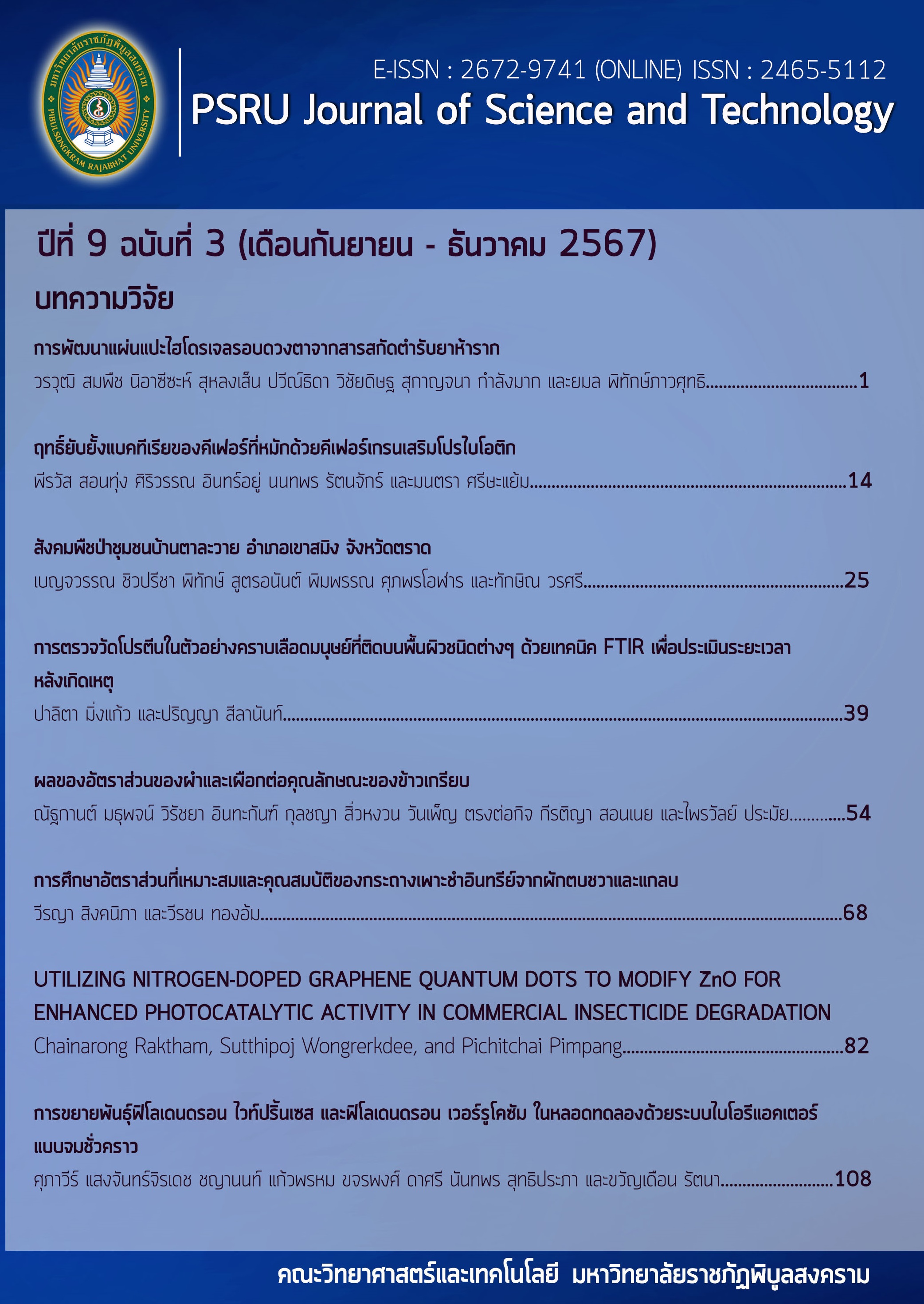INVESTIGATION OF PROTEIN IN HUMAN BLOODSTAIN SAMPLE ON VARIOUS SURFACE TYPES USING FTIR TECHNIQUE TO ASSESS THE POST-INCIDENT TIME
Keywords:
Post-incident time, Bloodstain, Protein, SurfaceAbstract
Estimation of the time after an incident in forensic science can be done by analysis of biological evidence at the crime scene that change over time. Biological evidence can be found in the crime scene. This research aims to study the age of blood stains from changes of protein within the blood using the Fourier Transform Infrared Spectroscopy (FTIR) in human bloodstains on various types of surfaces. The experimental research was carried out by using blood samples from volunteers without anticoagulants. The blood was dropped on different surfaces, cotton, plywood, and black plastic bags. Protein changes were then monitored directly from the sample surface at 0, 2, 4, 6, 9, 12, 24, 48, 72, and 96 hours after blood dropping down. It was found that the amide peaks represented as observed protein in bloodstain were detected. The amount of protein showed a significant downward trend over times. Consistent trends of protein decrease were observed among tested surfaces, except on the cotton. This is because the porosity of the fabric affects the protein content density per surface area. The linear relationship between protein versus times was found to be inverse variation during 0-2 hours. This is due to changes in the secondary structure of the protein. After 9 hours, the protein changes were found to be stabilized in all tested surfaces. Hence, the measured protein from real bloodstain under the observed time frame can be used to estimate the age of bloodstain at the crime scene. Advantages of this technique include direct measurement from the surface and non-destructive method.
References
กฤษณะ พวงระย้า. (2561). การประมาณอายุของคราบเลือดด้วยเทคนิคโครมาโตกราฟีของเหลวสมรรถนะสูง (HPLC). (วิทยานิพนธ์ปริญญามหาบัณฑิต). มหาวิทยาลัยราฎภัฏเพชรบุรี, สาขาวิชาเคมี.
จิณห์นิภา ปาวะภินันท์, และศิริรัตน์ ชูสกุลเกรียง. (2566). การประเมินอายุคราบเลือดจากการวัดค่าสีด้วย Spectrophotometer และด้วยเทคนิค ATR-FTIR. (วิทยานิพนธ์ปริญญามหาบัณฑิต). มหาวิทยาลัยศิลปากร, บัณฑิตวิทยาลัย, สาขาวิชานิติวิทยาศาสตร์.
ปาเลวี งามขำ, และธิติ มหาเจริญ. (2561). การประมาณอายุของคราบเลือดด้วย UV-Visible Spectrometer Age Estimation of Bloodstain by Using UV-Visible Spectrometer. วารสารวิชาการบัณฑิตวิทยาลัยสวนดุสิต, 14(2), 215-230.
พรวีนัส งามเสมอ. (2553). การประมาณอายุของคราบเลือดจากการเจริญเติบโตของแบคทีเรีย. (วิทยานิพนธ์ปริญญามหาบัณฑิต). มหาวิทยาลัยศิลปากร, สาขาวิชานิติวิทยาศาสตร์.
สราวุธ แหยมศิริ, ศิริรัตน์ ชูสกุลเกรียง, และธนวรรณ วัฒนพร. (2554). การตรวจหาอายุคราบโลหิตด้วย Fourier Transform Infrared Spectroscopy. Veridian E-Journal, Silpakorn University (Humanities, Social Sciences and arts), 5(2), 721-729.
Branden, C.I., & Tooze, J. (2012). Introduction to protein structure. New York: Garland Science.
Chonanant, C., Jearanaikoon, P., & Tippayawat, P. (2017). Applications of FTIR technique in Biomedical Sciences. Thammasat Medical Journal, 17(4), 641-652.
Lin, H., Zhang, Y., Wang, Q., Li, B., Huang, P., & Wang, Z. (2017). Estimation of the age of human bloodstains under the simulated indoor and outdoor crime scene conditions by ATR-FTIR spectroscopy. Scientific reports, 7(1), 13254.
Panta, O., Mongesvit, K., Chayothai, N., & Bunroek, P. (2022). Detection of Human Bloodstains on Natural, Synthetic and Mixed Fabrics by The BlueStar Method. Journal of Criminology and Forensic Science, 8(1), 17-30.
Schaller, J., Gerber, S., Kaempfer, U., Lejon, S., & Trachsel, C. (2008). Human blood plasma proteins: structure and function. U.S.A.: John Wiley & Sons.
Thongpagde, W., & Saksiri, N. (2022). Developing the Forensic Evidence and Problem in Murder Prosecution. Journal of Criminology and Forensic Science, 8(2), 186-203.
Downloads
Published
How to Cite
Issue
Section
License
Copyright (c) 2024 PSRU Journal of Science and Technology

This work is licensed under a Creative Commons Attribution-NonCommercial-NoDerivatives 4.0 International License.
กองบรรณาธิการขอสงวนสิทธิ์ในการปรับปรุงแก้ไขตัวอักษรและคำสะกดต่างๆ ที่ไม่ถูกต้อง และต้นฉบับที่ได้รับการตีพิมพ์ในวารสาร PSRU Journal of Science and Technology ถือเป็นกรรมสิทธิ์ของคณะวิทยาศาสตร์และเทคโนโลยี มหาวิทยาลัยราชภัฏพิบูลสงคราม และ
ผลการพิจารณาคัดเลือกบทความตีพิมพ์ในวารสารให้ถือมติของกองบรรณาธิการเป็นที่สิ้นสุด






